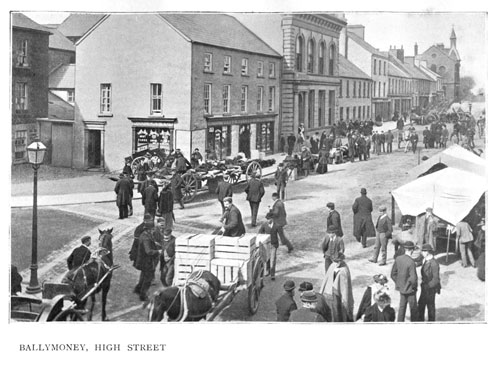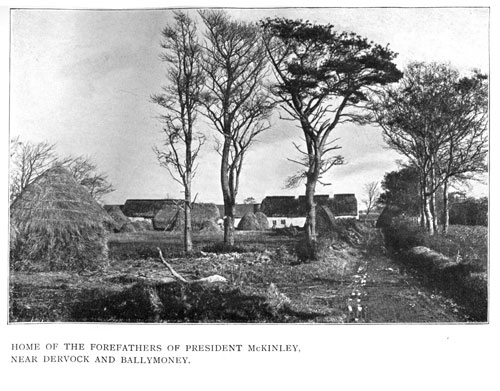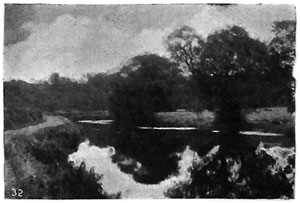Chapter I.
EARLY SETTLERS OF THE ROUTE.
 AT the accession of James I. the condition of the Province of Ulster was deplorable. It had been so long the scene of perpetual rebellions and feuds that the country lay almost a waste, covered with dense woods and swamps. The number of its inhabitants had been greatly reduced by war and disease, and those that remained were sunk in abject poverty. The religious condition of the province was equally wretched; writers of the time assert that "divine service had not for years together been used in any parish church throughout Ulster, except in some city or principal towns." This state of affairs induced the king to carry out what is known as the Plantation of Ulster, by planting on the forfeited lands of the rebellious chiefs settlers from England and Scotland. The greater part of the North-Eastern district was occupied by natives of Scotland, who were induced to come across by the proximity of their own country, by the troubles they had passed through at home, and by the prospect of obtaining more fertile lands in Ulster. One of the reasons given in a manuscript history of the times, quoted by Dr. Reid, for the small number of English who came over is as follows, "that the marshiness and fogginess of this island was still found unwholesome to English bodies, more tenderly bred, and in a better air."
AT the accession of James I. the condition of the Province of Ulster was deplorable. It had been so long the scene of perpetual rebellions and feuds that the country lay almost a waste, covered with dense woods and swamps. The number of its inhabitants had been greatly reduced by war and disease, and those that remained were sunk in abject poverty. The religious condition of the province was equally wretched; writers of the time assert that "divine service had not for years together been used in any parish church throughout Ulster, except in some city or principal towns." This state of affairs induced the king to carry out what is known as the Plantation of Ulster, by planting on the forfeited lands of the rebellious chiefs settlers from England and Scotland. The greater part of the North-Eastern district was occupied by natives of Scotland, who were induced to come across by the proximity of their own country, by the troubles they had passed through at home, and by the prospect of obtaining more fertile lands in Ulster. One of the reasons given in a manuscript history of the times, quoted by Dr. Reid, for the small number of English who came over is as follows, "that the marshiness and fogginess of this island was still found unwholesome to English bodies, more tenderly bred, and in a better air."
Sir Randall McDonnell, afterwards first Earl of Antrim, was at that time in possession of the wide expanse of country known as the Route and Glynns, extending from Larne to Coleraine; by his wise plans, and judicious behaviour in the face of plots and suspicions he managed to retain possession of these estates, and to obtain letters patent from King James I. in 1603, granting him the entire region.
Soon after this time he encouraged Scottish settlers to come over and occupy the lands, the former owners of which had been killed or driven away in the wars. These Scotsmen seem to have lived in the midst of many native Irish who were still retained as tenants. Another body of Scotsmen was driven across to settle in the Route by the following events.
In a raid organized by Angus McDonnell, a Scottish kinsman of Sir Randall, in 1607, a number of Presbyterian settlers who had been planted in the promontory of Cantire in Scotland by the Argyles were driven out, and compelled to take refuge on the Antrim coast with their cattle and their goods. The Rev. George Hill in the "McDonnells of Antrim," narrates how "Sir Randall McDonnell received them, Presbyterians though they were, and these people were the more welcome, no doubt, because of their bringing with them the means of stocking their farms." In the same interesting and valuable work may be found a statement made in an old document on behalf of the Earl of Antrim, "that he hath planted his owne lands in Ireland with Scotsmen that are Protestants, that hath given the ministers good stipends, some 200 lb., some 300 lb. a piece, and hath settled his lands best of any in the North of Ireland." From these facts it is evident that a large number of these settlers in the Route must have belonged to the Presbyterian Church. Judging from the names which appear in ancient records of the Antrim estates some of the families are clearly from the Highlands and the Western Islands, but a large proportion seem to have been lowlanders. Such people bringing with them from their native land their prevailing religious sentiments and their steady attachment to Presbyterianism, probably formed themselves at a very early period into societies for religious worship; although a considerable time may have elapsed before they obtained the services of a settled ministry.
In an admirable account of the congregation of Ballymoney by the Rev. R Park, M.A., for many years minister of that church, drawn up about the year 1820 in accordance with the instructions of the Synod of Ulster to all its ministers, and to which frequent reference will be made, it is stated that "there is every reason to believe that the Presbyterian congregation of Ballymoney was amongst the first of those societies for public worship formed by the families who were encouraged in the reign of James I. to emigrate from Scotland." From fragmentary church documents and from family records and tradition a considerable amount of information can be gained about the persons who were connected with this early society of Presbyterians.
Through the kindness of Prof. John Park, M.A., D.Lit., professor of logic and metaphysics in the Queen's College, Belfast, and son of the Rev. R Park, an old manuscript book has been preserved and has come into the possession of the Session of the congregation. This book, brown and worn with age, many of its leaves torn and defaced, and parts of it missing altogether, is all that remains of the records of the congregation of Ballymoney from its beginning till the year 1817. The actual period covered by the book is the space of time between the years 1730-1759. It contains fragments of a baptismal and marriage register and a few minutes of meetings of Session, but the greater portion of it is occupied with the congregational accounts. On the pages of these accounts quaint and curious entries are sometimes made dealing with notable events in congregational affairs, and sometimes with important episodes in the history of the country. In its later years this interesting volume seems to have fallen into the hands of some enterprising merchant of the town, who, no doubt owing to the scarcity and expensiveness of paper, made entries of his business transactions on the blank leaves, adding a few Latin quotations and a prescription for the scurvy, and closing his journal with the mysterious note on a particular date "I heard something very strange."

Amongst the earliest names occurring in this old record are the following: John Boyd, R McElhose, Benjamin Boyle, R Biggart, John Hopkin, Hugh McMaster, John Hamil, Thomas Elder, John Lusk, John Ramsay, Alex. Dunlop, and Alex. Calderwood; all of whom were elders of the church, and took part in the meetings of Session. Several of these are of special interest because they are the direct ancestors of families still in connection with the Presbyterian Churches of Ballymoney.
The Boyds of the Route were a widely scattered family, and are mentioned in the "Macdonnells of Antrim" as amongst the first settlers on the estate, and several members of this family were elders in the congregation. The Biggarts had also many branches in the district. The Hopkins family gave many elders to the Church, and are the ancestors of Mr. James Jordan, one of the present elders of 1st Ballymoney.
The Hamils, Elders and Lusks, the Ramsays and McMasters have branched out in many directions, and have given many prominent and useful members to the Presbyterian Church. Dunlop is another name mentioned by the Rev. George Hill as an original settler. The Calderwoods reach far back in local history. There is a well authenticated tradition that the house of Alex. Calderwood in Semicock was surrounded and burned during the 1641 rebellion, that several members of his family were killed, and the rest escaped to Coleraine.
In the Minutes of the Synod of Ulster, names of representative elders from Ballymoney occur in addition to those already mentioned, such as James Henry, ancestor of a family for many years active members of the church; Gilbert McFedrick, a name which also occurs in the Register as McPhedrix; Hugh Hamilton who seems to have been a very active member and constantly attended the Synod. The Hamiltons are mentioned in a document of 1661 as holding along with other lands "the two partes of the quarter of Monigobane " (Moneygobbin) for "one paire of gloves," and their descendants held this property for a long period.
James Moor is frequently mentioned in the Synod minutes as representing Ballymoney; this family spread into many branches, and many persons at the present time can claim them as ancestors. R Given's name appears very early on the list, and his representatives may still be found in the district. There occur also the names of Dan Snell, and Adam Caldwell, and the latter was clearly a man whose business capacity was found very useful to the church. Several Browns are mentioned as elders deputed by the Ballymoney congregation, and one James Brown as early as 1728.
Outside the ranks of the eldership of that early period, there are many names recorded in the old Baptismal and Marriage Register already referred to.
A careful examination of these shows in what an extraordinary way families whose history reaches back to the earliest days of the Plantation have maintained their existence and their names till the present day. Cummock (Camac), frequently in the list, is certainly one of the oldest names in the district; Robinsons and Rorisons spread over large tracts of land, as also did the Gettys and Whites, there are Sinclairs for generation after generation and Orrs stretching back in a long line. From an interesting old will printed by Dr. Taylor, and now in the possession of the representatives of the Robinson family, and dated 1769, it appears that the Robinsons settled about Culdoo and Newbuildings, and in addition to the greater part of these townlands owned large tracts in Carnately, Polentamney, and possibly Tullaghans. There are many Knoxes and Pinkertons, and Hunters and Wilsons, and Fullertons and Harts, all of them very early occupiers of lands. The names of Bickett, Lamont, Tylor (Taylor), Niven, Warnock, McDowel, McNeil, Blair, Hannah, Kilpatrick, Wyly, Neal, Gamble, Polick, Esdale, Bar, McClure, Anderson, Hemphill, Picken, McMichel, Lowdon, McCurdy, Houston, Taggart, Kelly, Porter, Wright and Borelan are to be found in the worn old pages of the record. Again and again appear the names of Stewart, Adams, McCracken, Thompson, Hay, Lilly, Cooper, Small, Young, and Slowen (Sloan). There were McCrellises and Macklyeals, Mellets and Askines (Erskine) in those days. There were an Aaron Forsythe, a Quentin Dick, an Adam Templeton, and a great number of Pattisons. There are many Tweeds in the list, and a great number of McKinlays. The Dinsmoors, connected with many families here, transplanted to America and flourishing there, appear very early in the Register.
Then come the Highland names. There are several McPhersons and Gordons, there is a Neal and a Laughlin McLane, there are a great number of Campables (Campbell), probably from Argyle and Cantire. There are McDuffies, sometimes called McPhie, and now written Macafee, a branch of the McDuffies of Colonsay, who settled at Culresheskin (Currysisken), where they are now represented by Mr. Thomas Macafee, one of the elders of the congregation.
Mention is also made in the record of a Daniel and a Malcolm Cameron, members of the clan who were driven from their highland homes after taking part in the rebellion of 1715. They brought with them their good broadswords, and it is stated by Mr. James Cameron, of Ballymoney, that at the time of the 1798 rebellion it became necessary to hide these swords by burying them in a garden, but the hiding-place was forgotten and has never since been discovered.
The name McKighan also occurs in the list, which may stand for the modern form McKeague, a family which has given several elders and ministers to the Church, including Mr. Andrew McKeague, at present an elder in the congregation. One curious name appears in the Register oftener, almost, than any other, viz:-- McPhedrix.
Such were the men who formed the congregation in its earliest days. Such were the men who found the lands of Route almost a desert, and in the midst of endless difficulties and untoward circumstances, constantly in danger, often oppressed and almost crushed, but enduring unto the end, by their stern patience and unceasing toil, turned the wastes into fertile fields and made the desert blossom as the rose. Such were the men who were the backbone of the Presbyterian Church in Antrim, who were true and loyal in the darkest days to their faith, and in the providence of God, built the foundations firm and sure. To such an ancestry their descendants, who are now to be found in all the Presbyterian Churches of Ballymoney and the surrounding district, may look back with pardonable pride.
Many of the Scottish families first settled in the Route have since, at different periods and from varied causes, emigrated to America, and have had an important share in moulding the history of the Great Republic, and of the Dominion of Canada. One of these families, the McKinleys, from the neighbourhood of Dervock, have become famous in these days by providing a President for the United States of America.
The town of Ballymoney, in which the congregation had its centre, consisted in those days of a few small houses on the highway between Ballymena and Coleraine, the houses being situated where Meeting House Street now is.
In an account of the expedition against the Scots, led by the deputy Sussex in 1556, it is stated by Phil Butler, the pursuivant:-- "This day we came by a bishop's house, which was with a castle and a church joined together in one, called Ballymonyn" (Carew MSS.). With regard to this passage, Rev. Canon Benson, Rector of Ballymoney, in an account of the parish, quotes the following from "Reeves Ecclesiastical Antiquities":-- "The castle here mentioned and the bishop's house occupied the site on which the old market house in that town was afterwards built, and their walls extended northward so as to meet those of the ancient church, the position of the latter being indicated by a square tower bearing the date of 1637. No vestiges of the castle or of the bishop's house now remain. The old church was superseded by a new one in 1637, and the latter was burned during the outbreak of 1641."

The old ivy-clad tower in the midst of the burying ground, which forms the frontispiece of this book, is all that remains of the ancient Parish Church, the roof of which was burned, it is said, by Alaster Macdonnell in the outbreak of 1641. The same Alaster utterly defeated the army of Archibald Stewart, which had marched against him from Coleraine, at a place called the Laney, a short distance from Ballymoney, in 1641.
A great part of the district was laid waste with fire and sword during the insurrection, and those who escaped with their lives were driven to take refuge in fortified towns such as Coleraine.
This was the condition of affairs when the Scotch regiments arrived in the North of Ireland to stem the tide of rebellion and restore tranquility to the unhappy country.


